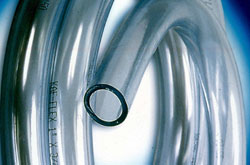|
PVC has
made it possible for a patients and healthcare
professionals to access a wide range of medical
applications with optimal technical performance,
safety, and comfort in use.
PVC is
commonly used in a wide range of medical applications
for screening, diagnosis, treatment and care, as well
as in the creation of safe healthcare environments.
By
adding plasticisers, it can be made with unparalleled
softness and flexibility, benefiting patient comfort
and hospital care. In addition to their versatile
nature, PVC healthcare applications can easily be
sterilised while keeping their key properties, such as
resistance (to tears, scratches and kinks) and
flexibility. The use of PVC in both single and
multiple-use medical devices has proved indispensable
in reducing the risk of life-threatening and
healthcare acquired infections.
As an
example, PVC is used for floor covering in hospitals
and other buildings where hygiene is paramount.
PVC-based flooring is much easier to keep clean and
hygienic than the alternatives currently on offer. It
has a very good chemical resistance, which means it
lasts longer under the use of aggressive products for
cleaning and disinfecting in hospitals.
Single-Use Applications
Over 50
years ago, medical products containing PVC were
originally developed as replacements for natural
rubber and glass. Medical devices made of these
traditional materials required cleaning and re-sterilisation
before re-use.
The low
cost, safety, high performance and versatility of the
PVC material made it possible to manufacture
single-use devices. In the early sixties this resulted
in a revolution within the healthcare sector. In fact,
PVC medical applications can be easily sterilised
while keeping their key properties, such as
flexibility and resistance to tears, scratches and
kinks. Therefore PVC based devices improved medical
safety by reducing the risk of life threatening and
healthcare acquired infections caused by traditional
and multiple use medical devices.
Over
the years, PVC has proved to be a safe, performing and
cost-efficient material for healthcare delivery and is
now the most widely used plastic in pre-sterilised
single use medical applications. As a result, today
almost 30% of all plastic-based disposable medical
devices used in hospitals are made from PVC. PVC
devices are easier to sterilise, transparent,
chemically stable, cost-effective, easy to process
using different technologies and have long shelf life
stability.
The two
main application areas for medically approved PVC
compounds are flexible containers and tubing.
Flexible Containers
PVC is
used worldwide to make blood bags and other
non-breakable containers used in medicine. Those are
crucial and widely used in modern healthcare services
every day. Soft PVC is considered the clear material
of choice for these kinds of devices. It is light and
almost impossible to tear, making it ideal for quick
and effective emergency treatment of accident victims.

|
The
properties of PVC make it the softest and most
flexible plastic to use for the production of
disposable medical devices. Its softness makes it the
best choice in neonatal wards for new and premature
babies, to ensure they are as comfortable as possible.
They are noiseless and prevent odours from escaping,
thereby providing extra comfort and hygiene.
Healthcare professionals can also appreciate this
softness property when wearing medical gloves.
Flexible Containers
Include:
-
Containers for blood,
urine continence and ostomy products
-
Containers for
intravenous solution giving sets
Flexible Tubing
Typical requirements for
tubing used in medical devices include clarity,
flexibility, kink resistance, toughness, scratch
resistance, ease of bonding with common solvents or
adhesives, and suitability for sterilisation. While
other thermoplastic polymers have been used to replace
flexible PVC in medical tubing, none to date has been
able to match the performance and advantages provided
by PVC. Alternatives have so far not succeeded in
meeting the optimal low cost and kink resistance
levels that PVC flexible tubing offers.
Tubing Includes:
-
Blood taking and blood
giving sets
-
Catheters and cannulae
-
Heart and lung bypass
sets
-
Tubing for dialysis,
endotracheal, feeding and pressure monitoring
Other PVC
Applications In Healthcare
PVC’s
very versatile properties make it suitable for a broad
range of other applications in healthcare settings.
PVC floors
Plasticised PVC floors can be found in hospitals all
around the world. The smooth, tough surface of the
upper wear layer prevents dust and dirt from building
up and stops microbes from breeding, keeping the rooms
sterile and therefore playing a crucial role in
preventing infections. The robust surfaces of soft PVC
reduce the need for cleaning and the use of polish.
PVC wall coverings
Soft
PVC wall coverings are also a clear favourite in many
hospitals thanks to their aesthetic, hygiene and
cost-effective qualities. Today’s PVC wall coverings
are attractive, available in grades of thickness,
suited to heavy traffic and will stand up to years of
heavy use. Not only are these wall coverings easily
cleaned, they are also easily repaired should damage
occur.
PVC
Also Offers Specific Advantages In Other Healthcare
Applications Such As:
-
Surgical and examination
gloves
-
Inflatable splints
-
Inhalation masks
-
Blister packs for pills
and tablets
-
PVC coated mattress
covers – hygienic and easy to clean
-
Easily fabricated oxygen
tents, relying on the welding characteristics of PVC
combined with good transparency
-
Water and drainage pipes
-
Fire-resistant cabling
in electrical and telecommunications equipment
|
